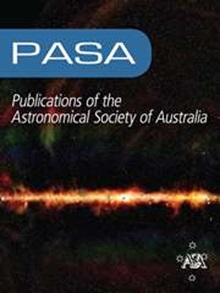欧洲航天局火星快车的监测活动(2013-2020年),研究行星际等离子体闪烁
IF 4.6
3区 物理与天体物理
Q1 ASTRONOMY & ASTROPHYSICS
Publications of the Astronomical Society of Australia
Pub Date : 2023-02-21
DOI:10.1017/pasa.2023.12
引用次数: 2
摘要
利用欧洲甚长基线干涉测量(EVN)网络和塔斯马尼亚大学的望远镜,在2013-2020年间定期观测火星快车(MEX)航天器发射的x波段(8.42 GHz)无线电信号。我们提出了一种通过量化等离子体对我们无线电信号的影响来描述太阳风参数的方法。在这样做的过程中,我们确定了无线电信号上所有未补偿的影响,并看到是哪些日冕过程驱动了它们。从技术的角度来看,量化等离子体对无线电信号的影响有助于精确跟踪航天器的相位参考。在太阳延伸角从0到180度的火星轨道上,确定了信号的相位波动。计算的相位残差允许确定相位功率谱。通过去除机械和电离层噪声的影响,计算出沿视线方向太阳等离子体的总电子含量。光谱指数为$-2.43 \pm 0.11$,与Kolmogorov湍流一致。理论模型与太阳延伸度较低时的观测结果一致,但在太阳延伸度较高时(160°),我们看到观测值更高。当上行链路和下行链路信号由于通过相同的等离子体片而正相关时,就会引起这种情况。本文章由计算机程序翻译,如有差异,请以英文原文为准。
A monitoring campaign (2013–2020) of ESA’s Mars Express to study interplanetary plasma scintillation
Abstract The radio signal transmitted by the Mars Express (MEX) spacecraft was observed regularly between the years 2013–2020 at X-band (8.42 GHz) using the European Very Long Baseline Interferometry (EVN) network and University of Tasmania’s telescopes. We present a method to describe the solar wind parameters by quantifying the effects of plasma on our radio signal. In doing so, we identify all the uncompensated effects on the radio signal and see which coronal processes drive them. From a technical standpoint, quantifying the effect of the plasma on the radio signal helps phase referencing for precision spacecraft tracking. The phase fluctuation of the signal was determined for Mars’ orbit for solar elongation angles from 0 to 180 deg. The calculated phase residuals allow determination of the phase power spectrum. The total electron content of the solar plasma along the line of sight is calculated by removing effects from mechanical and ionospheric noises. The spectral index was determined as
$-2.43 \pm 0.11$
which is in agreement with Kolmogorov’s turbulence. The theoretical models are consistent with observations at lower solar elongations however at higher solar elongation (
$>$
160 deg) we see the observed values to be higher. This can be caused when the uplink and downlink signals are positively correlated as a result of passing through identical plasma sheets.
求助全文
通过发布文献求助,成功后即可免费获取论文全文。
去求助
来源期刊
CiteScore
5.90
自引率
9.50%
发文量
41
审稿时长
>12 weeks
期刊介绍:
Publications of the Astronomical Society of Australia (PASA) publishes new and significant research in astronomy and astrophysics. PASA covers a wide range of topics within astronomy, including multi-wavelength observations, theoretical modelling, computational astronomy and visualisation. PASA also maintains its heritage of publishing results on southern hemisphere astronomy and on astronomy with Australian facilities.
PASA publishes research papers, review papers and special series on topical issues, making use of expert international reviewers and an experienced Editorial Board. As an electronic-only journal, PASA publishes paper by paper, ensuring a rapid publication rate. There are no page charges. PASA''s Editorial Board approve a certain number of papers per year to be published Open Access without a publication fee.

 求助内容:
求助内容: 应助结果提醒方式:
应助结果提醒方式:


